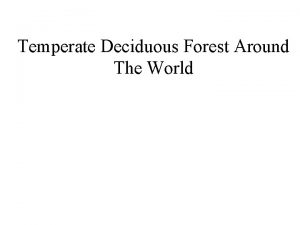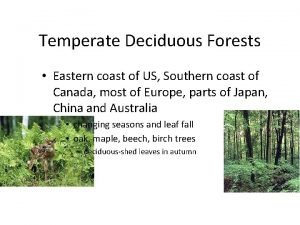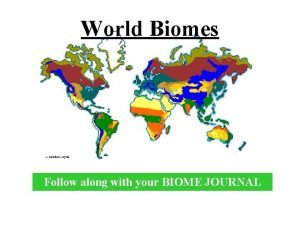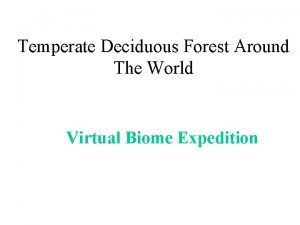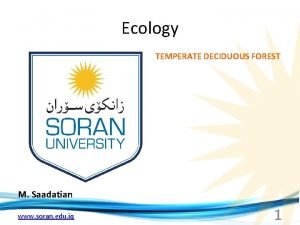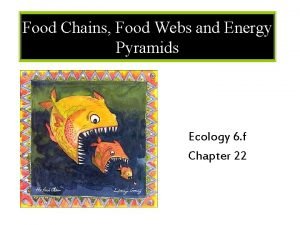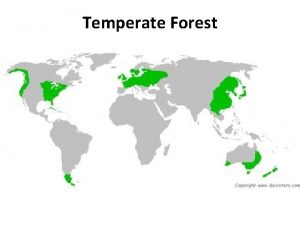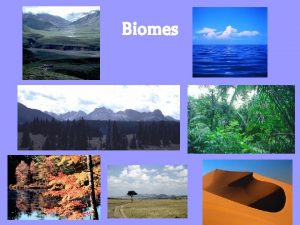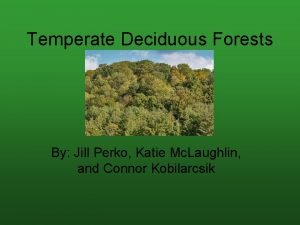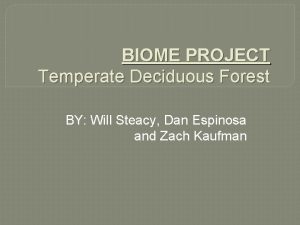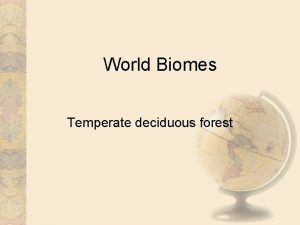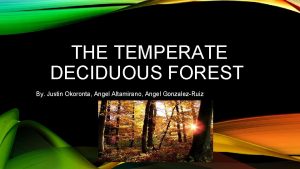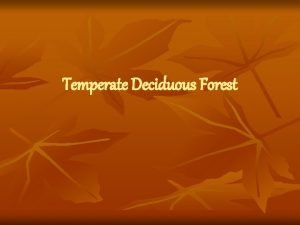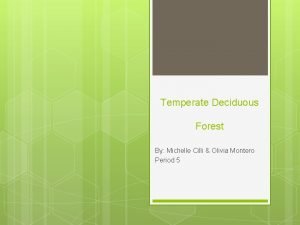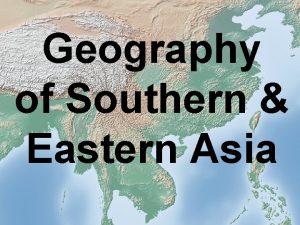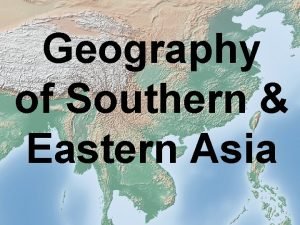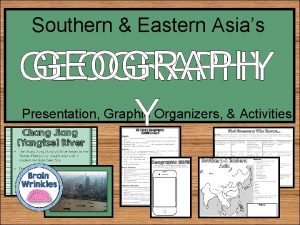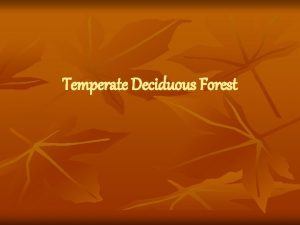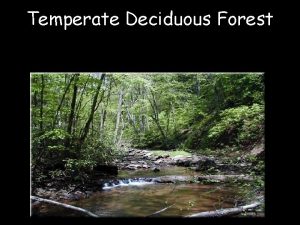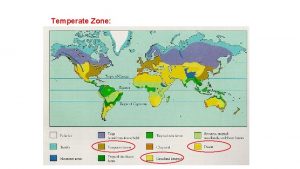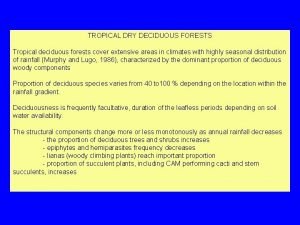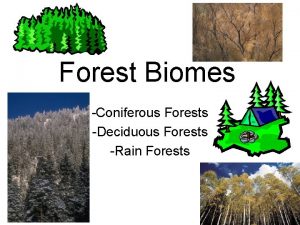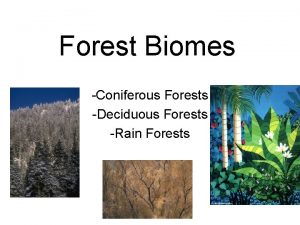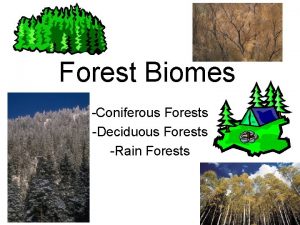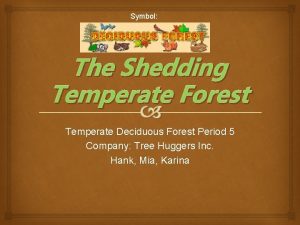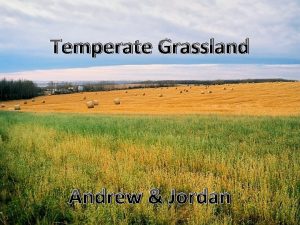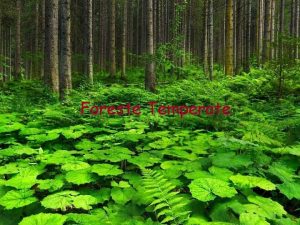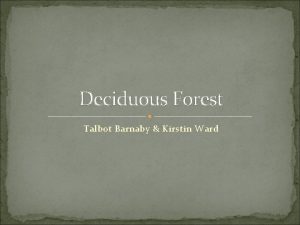Temperate Deciduous Forests Eastern coast of US Southern




















- Slides: 20

Temperate Deciduous Forests • Eastern coast of US, Southern coast of Canada, most of Europe, parts of Japan, China and Australia • changing seasons and leaf fall • oak, maple, beech, birch trees – deciduous-shed leaves in autumn

Temperate Deciduous Forests • rainfall sufficient year round • cold winters halt plant growth for several months

Temperate Deciduous Forests • animals hunted near extinction – protection and hunting regulations – deer, moose, gray foxes

Grasslands • North America, steppes of Russia, veld of South Africa, pampas of Argentina • interior portions of many continents – covered with grasses and small leafy plants – significant rainfall – hot summers and cold winters

Grasslands • interactions among animals and plants shape the environment • stable • do not undergo ecological succession • wheat, corn, other grains heavily farmed

Tropical Rain Forests • warms temperatures and rain fall year round • 200 -400 cm • 25 degrees C • South America, Southeast Asia, Africa, Central America

Tropical Rain Forests • home to more species of plants and animals than can be found in all the rest of the land biomes combined!!

Tropical Rain Forests • Trees grow up to 70 m • canopy » tree dwellers

Tropical Rain Forests • animal life is rich and varied • colorful insects and birds • reptiles, small mammals, amphibians

Tropical Rain Forests • many animals and plants produce chemicals that may be useful in fighting some types of diseases

Deserts • less than 25 cm of rainfall annually • Sahara in Africa • • • world’s largest desert rain almost NEVER falls wind hot and dry almost nothing grows lizards, insects, scorpions, snakes, birds

Deserts • Seasonal Deserts • some rainfall • Cold Deserts • brief rainy season » permits growth of grasses and shrubs • soil is often very fertile

Aquatic Biomes • Water ecosystems • freshwater, marine, estuaries • Abiotic factors that affect organisms found in the aquatic biomes • light intensity • amounts of O 2 and CO 2 dissolved in water • availability of organic and inorganic nutrients

Freshwater Biomes • Rivers, streams, lakes • drinking water, food • tiny plants and animal swim / drift through water • eaten by fishes and amphibians » eat vegetation and insects that fall into the water

Marine Biomes • ocean • covers most of the surface of the Earth • photosynthesis takes place in upper region • photic zone • 30 m to 200 m • phytoplankton and algae

Marine Biomes • • Intertidal zone Neritic zone Open-sea zone Deep-sea zone

Intertidal Zone • most difficult zone for organisms to live in • radical changes in their surroundings » clams, barnacles, seaweed, sea urchins, snails, starfish

Neritic Zone • extends from low-tide line to the edge of the open sea • large algae (seaweed) abundant » photic zone • giant kelp • meadows of turtle grass

Open-Sea Zone • phytoplankton are responsible for 80 -90% of Earth’s photosynthetic activity • eaten by larger animals

Open-Sea Zone • dolphins, whales, sea birds (albatrosses) • nutrients scarce • phytoplankton relatively low • limits the number of animals
 Deciduous forest amphibians
Deciduous forest amphibians Temperate forest animals adaptations
Temperate forest animals adaptations Characteristics of temperate deciduous forest
Characteristics of temperate deciduous forest Deciduous forest have
Deciduous forest have Temperate deciduous forest plant adaptations
Temperate deciduous forest plant adaptations Temperate deciduous forest plant adaptations
Temperate deciduous forest plant adaptations Desrt food web
Desrt food web Temperate forest biotic factors
Temperate forest biotic factors Temperate deciduous forest location map
Temperate deciduous forest location map Temperate deciduous forest latitude and longitude
Temperate deciduous forest latitude and longitude Temperate broadleaf forest plants
Temperate broadleaf forest plants Temperate deciduous forest definition
Temperate deciduous forest definition Climate in the temperate deciduous forest
Climate in the temperate deciduous forest Youtube youtube youtube
Youtube youtube youtube Tropical rainforest and temperate forest venn diagram
Tropical rainforest and temperate forest venn diagram Deciduous forest average rainfall
Deciduous forest average rainfall Secondary consumer forest
Secondary consumer forest Se asia's belief systems cloze notes
Se asia's belief systems cloze notes East asia physical map
East asia physical map Bay of bengal
Bay of bengal Sw asia geography cloze notes 1
Sw asia geography cloze notes 1

